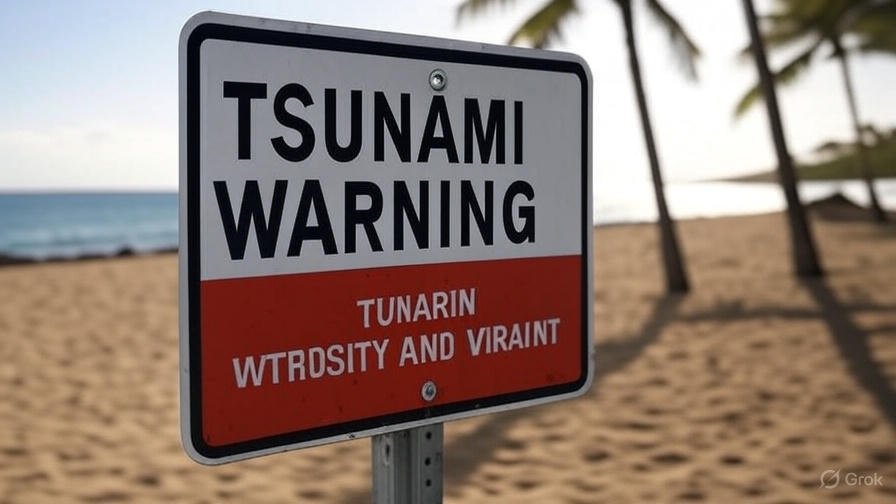Tsunami Warning Hawaii: Living in Hawaii, we’re no strangers to the power of the ocean. The islands’ beauty comes with a reminder of nature’s unpredictability, especially when it comes to tsunamis. Recently, a tsunami watch was issued for Hawaii following a 7.4-magnitude earthquake off Russia’s Kamchatka Peninsula on July 19, 2025, sending a ripple of concern through our communities. Thankfully, the watch was canceled within hours after experts confirmed no significant threat. But incidents like this remind us how important it is to stay informed and prepared. Let’s dive into what a tsunami warning means for Hawaii, why it matters, and how we can stay ready for the next one.
Table of Contents
Understanding Tsunamis and Their Impact
Tsunamis are not your average ocean waves. They’re massive, fast-moving walls of water triggered by events like underwater earthquakes, volcanic eruptions, or landslides. In Hawaii, our location in the Pacific Ocean puts us at risk for both local and distant tsunamis. Since 1946, over 220 people have lost their lives to tsunamis in Hawaii, including six on Oahu, making preparedness a critical part of island life.
- What causes a tsunami? Earthquakes under the sea, volcanic activity, or landslides displace massive amounts of water, creating waves that can travel at jet-like speeds of 500 mph in deep water.
- Why Hawaii? Our islands sit in the middle of the Pacific, surrounded by the Ring of Fire, a hotspot for seismic activity.
- Historical impact: The 1946 tsunami, caused by a 7.4-magnitude earthquake in the Aleutian Islands, killed 173 people in Hilo alone, with waves reaching 55 feet high.
The recent scare from the Kamchatka earthquake was a wake-up call, even if it ended without incident. It’s a reminder that tsunamis can strike with little warning, especially local ones, which can hit Oahu in as little as 30 minutes.
How Tsunami Warnings Work in Hawaii
The Pacific Tsunami Warning Center (PTWC) in Honolulu is our first line of defense. Operating 24/7, the PTWC monitors seismic activity and sea level changes across the Pacific, issuing alerts when needed. There are four levels of tsunami alerts, each with specific actions for residents:
- Tsunami Information Statement: No threat, just an FYI about a minor event.
- Tsunami Watch: A tsunami is possible but not confirmed. Stay alert and prepare.
- Tsunami Advisory: Strong currents or small waves are expected, dangerous for swimmers or boaters.
- Tsunami Warning: Significant flooding is imminent. Evacuate low-lying areas immediately.
For the July 2025 event, the PTWC issued a watch at 9:03 p.m. after the Kamchatka quake, estimating potential wave arrival by 2:43 a.m. By 9:42 p.m., they canceled it, confirming no tsunami threat based on data analysis. This quick response shows how far our warning systems have come since the devastating 1946 tsunami, which led to the creation of the PTWC.
Recognizing Natural Warning Signs
Sometimes, nature itself gives the first warning, especially for local tsunamis where time is short. If you’re near the coast and notice any of these signs, don’t wait for an official alert—act fast:
- Earthquake shaking: A strong quake that makes it hard to stand is a natural tsunami warning. Drop, cover, and hold on, then head inland once the shaking stops.
- Unusual ocean behavior: A sudden rise or retreat of water, exposing the ocean floor, or a loud roaring sound like a jet engine.
- Local vs. distant tsunamis: Local tsunamis, often caused by quakes near Hawaii Island, give you just minutes to react. Distant ones, like the Kamchatka event, may take hours to reach us.
During the recent watch, no natural signs were reported, and the PTWC’s data confirmed the ocean stayed calm. But knowing these signs can be a lifesaver when technology alone isn’t enough.

Preparing for a Tsunami in Hawaii
Preparation is key to staying safe. Whether you live in a tsunami evacuation zone or just visit the coast, having a plan can make all the difference. Here’s how to get ready:
- Know your zone: Check the Hawaii Tsunami Evacuation Map to see if your home, workplace, or school is in a red (standard) or yellow (extreme) evacuation zone. Oahu’s maps show safe green zones inland.
- Make a go bag: Pack essentials like water, food, medications, and important documents in case you need to evacuate quickly.
- Practice evacuation routes: Familiarize yourself with routes to higher ground, ideally by foot to avoid traffic jams.
- Stay informed: Tune into NOAA Weather Radio (162.550 or 162.400 MHz) or local news for updates during an alert.
The Hawaii Emergency Management Agency (HI-EMA) coordinates statewide siren tests and evacuation plans, ensuring counties are ready to sound the alarm. If you’re not in an evacuation zone, stay off the roads to keep them clear for evacuees and first responders.
Community Resilience and Moving Forward
Hawaii’s history with tsunamis has shaped a culture of resilience. From the 1837 Hilo disaster to the 1960 Chile tsunami that killed 61, we’ve learned hard lessons about preparedness. Community programs like TsunamiReady and the Hawaii Hazards Awareness and Resilience Program (HHARP) empower residents with knowledge and resources. The recent false alarm from the Kamchatka quake showed how well our systems work but also highlighted the need to stay vigilant.
- Get involved: Join local preparedness programs or take FEMA’s Community Tsunami Preparedness course.
- Educate others: Share evacuation maps and warning signs with family and friends.
- Support recovery: After events like the 2023 Lahaina wildfires, community solidarity helps rebuild stronger.
As we move forward, let’s keep talking about tsunami safety. The ocean is part of what makes Hawaii special, but it demands respect. By staying informed, prepared, and connected, we can face the next tsunami warning with confidence, knowing we’re ready to protect ourselves and our ohana.